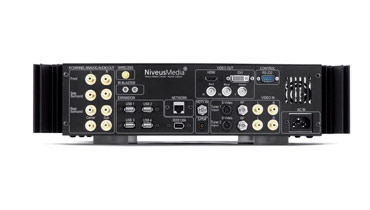Niveus Media Rainier Edition 500HD Media Center PC system Page 2

PERFORMANCE
The wonders of Windows Vista Media Center have been covered previously in these pages - most recently in John Sciacca's review of S1Digital's FX Edition - so I won't go into detail here. In short, it provides a dynamic widescreen interface for browsing various media, including recorded and live digital-cable channels, music ripped from your CD library, subscription-based music services, Internet radio and video channels, and digital photos.
Niveus adds custom tabs within the Media Center interface so you can buy and download high-rez music from the impressively deep MusicGiants library as well as check your local weather forecast. And plenty of additional plug-ins are floating around the Web, like vmcNetflix, which lets Netflix subscribers use the Media Center to stream on-demand movies from that service. The Niveus mothership discourages the use of third-party plug-ins, but a dealer can test out and qualify them for you before the system gets installed.
 |
As I browsed the sizable video and music resources suddenly at my disposal, the Rainier's performance proved speedy and responsive. The experience was light-years ahead of that provided by my cable-company-leased DVR. And unlike the results of our last test of a Media Center PC with CableCARD, all standard- and high-def channels could be accessed when I attempted to tune into them from the channel grid.
One of the main reasons why I wanted to check out the Rainier Edition 500HD was to see how it fared as a Blu-ray Disc player. For the most part, it worked extremely well: 1080p images were crisp, showed strong contrast, and were free of any stuttering motion. The ArcSoft player's audio decoding also proved glitch-free - although the software's buggy information screen, which displayed data rate for the last-played (instead of the current) soundtrack format, made it hard to verify any audio tech specs. Another gripe about playback: there's no remote-control button or software command for ejecting Blu-ray Discs. I had to get up and paw at the minuscule, recessed eject button on the Rainier's front panel - a user-unfriendly touch in an otherwise bulletproof design.
The Rainier's video processing with 1080i (interlaced) programs and standard-definition movies and TV shows was passably good but not stellar. It failed the full suite of tests on the Silicon Optix HQV Benchmark Blu-ray test disc, and some tests on the DVD version of the same - surprising for an ISF-certified piece of gear. Any shortcomings here won't be an issue for Blu-ray movie playback, since those discs are encoded at 1080p resolution. But it does mean that jaggies (stairstep artifacts) might appear on both 1080i high- and standard-def programs originating on video, particularly in shots with camera motion. (Sure enough, when I went looking for artifacts, I spotted some.)
The Rainier unit that I tested had a fairly noisy hard drive that emitted a steady grinding sound as it kept pace to process the vast amounts of accumulated data. Unfortunately, this effectively canceled out the contributions of Niveus's passive-cooling design toward making the Rainier noise-free. When I ran this problem by the company, I was told that my review sample contained an older type of hard drive, and that a new, quieter model designed specifically for A/V applications is currently being installed in all of the company's Media Center PCs.
Now let's consider the Edge Media Center extender. It differs from extenders by companies like Linksys and D-Link in that it's exclusively designed to be connected via Ethernet to a wired home network. And whereas those other units have the cheap look of Internet appliances, the Edge is a dead-ringer for the Rainier, right down to its 17-inch-wide heavy-duty aluminum chassis.
Another thing that differentiates the Edge extender is that it's essentially an Xbox 360 game console in a far prettier package. "Hmmm," you might be thinking, "why not just buy an Xbox to use as an extender and save myself some cake?" The answer is that the Xbox is notorious for its excessive fan noise - something that's not an issue when you're playing first-person shooters but that does factor in when you're listening to music or trying to hear dialogue in movies starring someone other than The Rock or Jason Statham (the thinking man's Rock).
With the Edge, Niveus basically neutered the Xbox 360 of its game-playing capability and then used the company's own industrial cooling know-how to make the extender dead quiet. What you're left with is the Xbox's powerful graphics-rendering engine and rock-solid A/V playback. The Edge's onscreen graphics display appeared to be just as fast, fluid, and crisp as the Rainier's. By comparison, the Linksys extender suffered from stuttering graphics and was notably slower in refreshing CD art on the Music Library screen.
BOTTOM LINE
As someone who has previously gone on record dissing the idea of PCs in the home theater, I'm ready to do an about-face. My time spent with Niveus Media's Rainier 500HD (and Edge extender and digital cable receiver) sold me on the concept. It will be painful to reconnect my cable DVR when I have to send the Rainier back - and I was already fed up with the glitchy performance of standalone Blu-ray players. Was my experience with the Rainier bug-free? Not exactly. But having used it as my main TV and movie-disc viewing source for the past few months, I'm amazed at how few glitches I've actually encountered. A single box to handle all of your media? At this point, you'd be crazy not to consider it.




